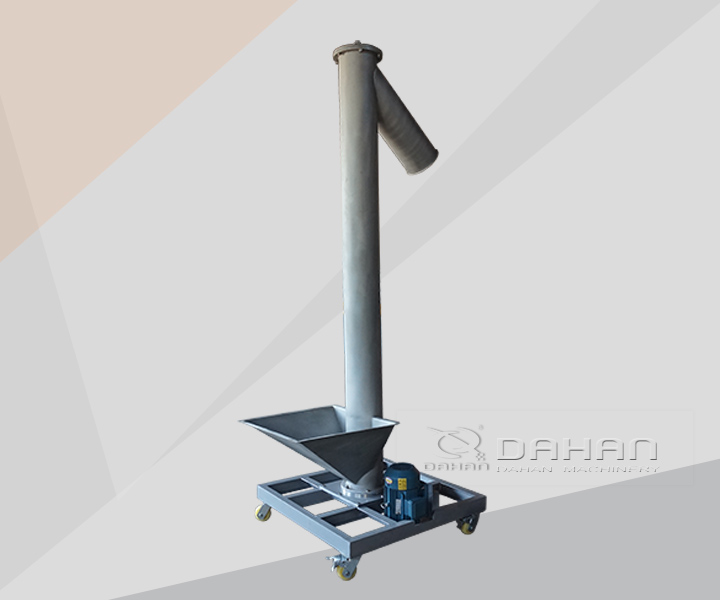
Flexible screw conveyors are a low-cost method for lifting almost any bulk material. Before specifying a flexible screw, it is important to understand the basic components and how they operate, as well as the advantages and limitations. With this knowledge, a comprehensive review of material properties and application details will ensure the selection of a suitable flexible screw conveyor, and the flexible screw conveyor will provide years of trouble-free service.
When choosing the flexible screw conveyor,you may need to provide the information as follows:
Product Density - What is the product bulk density in lbs./ft 3 (kg / m 3)?
Particle Size - What is the average particle size distribution of the material?
Mobility - Are they free flowing materials or packaging and bridging? Is the material applied?
Abrasion - Extremely abrasive materials can wear standard UHMWPE sleeves and may require a metal enclosure. Is the material ventilated and dusty?
Once the physical characteristics of the material to be moved are taken into consideration, the next step is to check the operational requirements.
Emission Rate - What is the required flow rate in lbs./hr (kg / hr)?
Unloading height - How high does the material need to move?
Layout - Usually the flexible screw conveyor has a 45 degree discharge angle, so the inlet hopper will be the same as the discharge height. Is there a barrier between the inlet hopper and the discharge point?
Frequency - How often does the screw conveyor operate? Is it continuous or intermittent?
Utilities - How much power is there in the installation location? Is compressed air ready for use, what is the pressure and flow?
Control - Is a simple on/off button sufficient, or does the process require a variable speed with interlock to start and stop the conveyor?
For free-flowing products, the basic screw conveyor settings for the inlet hopper, flat auger, casing and discharge head are sufficient. A typical 2", 3", 4", 5" or 6" nominal conveyor size will provide a flow rate of 50 to 500 ft 3 /hr. The size of the conveyor will be selected according to the desired flow rate. The product density and length of the conveyor are then used to determine the size of the motor and gearbox for the discharge head, based on the load.
For more challenging applications where the product does not flow freely, standard conveyors require bridging or ventilation modifications. Here are some of the most common modifications and challenges for each.
Auger Selection - There are many auger profiles in flexible screw conveyors, but the most common are: flat augers, flat augers with beveled edges, round augers and square augers. See Figure 3: Common auger profiles. The shape refers to the cross section of the wire itself. Flat augers are most effective because the larger faces move more material onto the screw conveyor for free flowing materials below 40 lbs./ft 3 (640 kg / m 3 ). A flat auger with beveled edges is a good choice for packaging or applying viscous materials. Round wire augers are used for heavier materials over 40 lbs./ft 3 (640 kg/m3). Square augers are best suited for heavy duty irregular shaped products.
Casing selection - The most common casing is conventional UHMW-PE, but can be chosen to solve static, corrosion, wear and temperature problems. Moving the dry material through the plastic case creates static electricity. If present, an enhanced conductive enclosure can be provided and grounded. A rugged stainless steel housing is available to improve wear, corrosion resistance and operation at high temperatures.
Center Core - The helical auger in the flexible screw has no central axis. For some materials, placing the central core of the UHMW-PE into this space prevents the material from falling back from the center of the auger, thereby increasing throughput. This is usually applied to materials that are extremely fluid and ventilated.
Hopper Angle - The square hopper is usually designed with a 60 degree sloping side to facilitate hopper outflow. The most difficult products, such as packaging and smearing titanium dioxide, require a round hopper with steeper sidewalls to facilitate the hopper's outflow.
Flow Assistant - For ventilation, bridging, rathole or packaged materials, it may be necessary to add flow aids to the inlet hopper. There is a pneumatically actuated fluidization pad that introduces air into the product. A second common choice is a rotary vibrator, which can be electrically or pneumatically actuated. A third common attachment is an electrically driven spiral or paddle auger mounted through the side wall of the hopper. For extremely difficult products, vibration and auger can be used.
The above information hopes to help you. If you need help, you can always consult us.
Address:China,Yanjin county forest park gate to the west 1000 meters north road.